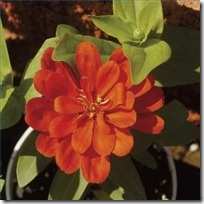Zinnia is a vibrantly colored garden flower of Central and South American origin. Various species range in height from a few inches to over a foot tall. Much like other annuals, zinnia is often transplanted as seedlings during spring and lasts until the fall frosts set in. While zinnia can be grown relatively easily from seeds, many gardeners prefer to purchase seedlings and transplant them for a more balanced, thicker flower bed. These flowers thrive in well-draining soil with plenty of exposure to the sunlight.
Difficulty: Moderately Easy
Instructions
Things You’ll Need:
- Zinnia seedlings
- Shovel or spade
- Fertilizer (optional)
- Peat moss (optional)
-
Store your home-grown or purchased zinnia seedlings indoors until the danger of frost has passed. Each region has its own average spring frost date, but it generally falls in March or April. The author of "Zinnia," published through the University of Illinois Extension, recommends planting home-grown zinnia roughly five weeks before the transplanting date.
-
Acclimate the seedlings for a week or two after the last frost of spring. According to "Transplanting Annuals Into the Garden," published through Penn State University’s Department of Horticulture, the acclimation process should be done gradually over 10 to 14 days. Move the plants outside for an hour or two each day. Increase their time outdoors progressively until the transplant date.
-
Prepare the soil in your flower bed by breaking it with a shovel or hand-held spade. Dig down about as deep as the height of the seedling’s current containers. Make holes sized to fit the seedling’s root mass snugly. Use the size of the seedling’s container as a guide. Mix fertilizer or compost with the soil to amend it, if needed.
-
Gently remove each seedling from its container. The soil inside should be relatively loose and require little force to remove. Handle the seedlings with care to avoid causing excess trauma to the root structure. Gently wipe away excess soil from the roots.
-
Place the root ball of each plant into the corresponding hole. The top of the roots should be slightly below the ground level. Pat dirt around the to top of the roots to bury them. Water the ground with a light sprinkle to help the soil settle around the newly transplanted roots.
Tips & Warnings
-
Transplant zinnia on cloudy days, mornings or evenings to shield the roots from exposure to the sun.
-
Cold temperatures can stall zinnia growth or kill it completely. Don’t move them outside on days with temperatures below 50 degrees F.


Deprecated: strpos(): Passing null to parameter #1 ($haystack) of type string is deprecated in /home/agriviek8Qv/agriviet.net/public_html/wp-includes/comment-template.php on line 2522